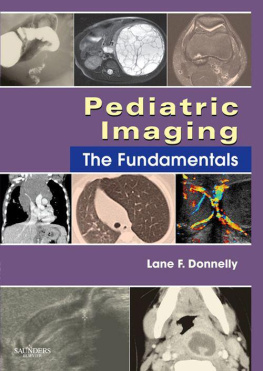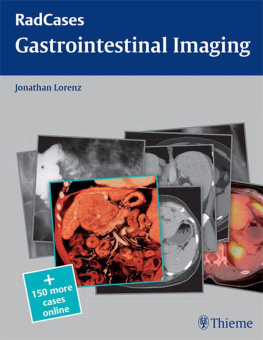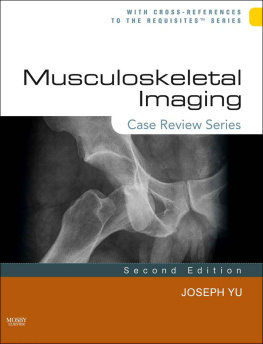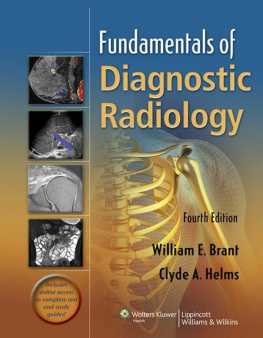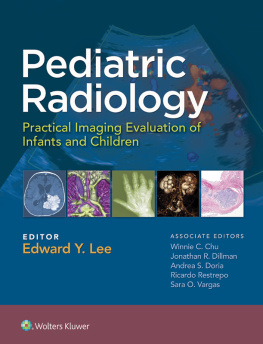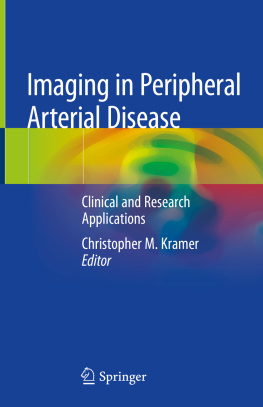Pediatric Imaging
The Fundamentals
First Edition
Lane F. Donnelly, MD
Radiologist-in-Chief, Department of Radiology, Cincinnati Childrens Hospital Medical Center
Professor of Radiology and Pediatrics, University of Cincinnati College of Medicine, Cincinnati, Ohio
Saunders Elsevier
Front Matter
Pediatric Imaging
The Fundamentals
Lane F. Donnelly, MD
Radiologist-in-Chief, Department of Radiology
Cincinnati Childrens Hospital Medical Center
Professor of Radiology and Pediatrics
University of Cincinnati Col lege of Medicine
Cincinnati, Ohio

Copyright
SAUNDERS
ELSEVIER
1600 John F. Kennedy Blvd.
Suite 1800
Philadelphia, Pennsylvania 19103-2899
PEDIATRIC IMAGING ISBN: 978-1-4160-5907-3
Copyright 2009, by Saunders, an imprint of Elsevier Inc.
.

Notice
Knowledge and best practice in this field are constantly changing. As new research and experience broaden our knowledge, changes in practice, treatment, and drug therapy may become necessary or appropriate. Readers are advised to check the most current information provided (i) on procedures featured or (ii) by the manufacturer of each product to be administered to verify the recommended dose or formula, the method and duration of administration, and contraindications. It is the responsibility of the practitioner, relying on his or her own experience and knowledge of the patient, to make diagnoses, to determine dosages and the best treatment for each individual patient, and to take all appropriate safety precautions. To the fullest extent of the law, neither the publisher nor the author assumes any liability for any injury and/or damage to persons or property arising out of or related to any use of the material contained in this book.
The Publisher

Library of Congress Cataloging-in-Publication Data (in PHL)
Donnelly, Lane F.
Pediatric imaging: the fundamentals/Lane F. Donnelly. 1st ed.
p. ; cm.
Includes bibliographical references.
ISBN 978-1-4160-5907-3
1. Pediatric diagnostic imaging. I. Title.
[DNLM: 1. Diagnostic Imagingmethods. 2. Child. 3. Infant. WN 240 D685p 2009]
RJ51. D5D66 2009
618.92'00754dc22 2008038937
Senior Acquisitions Editor: Rebecca S. Gaertner
Developmental Editor: Elizabeth Hart
Publishing Services Manager: Tina K. Rebane
Designer: Steve Stave
Marketing Manager: Catalina Nolte
Printed in China.
Last digit is the print number: 9 8 7 6 5 4 3 2 1
Dedication
For my wife, Carolina V. Guimaraes, MD. You are everything to me.
Preface
I know that as a resident, I retained more useful information when I read short and basic books over and over than when I read longer, more detailed texts once. The intention of this book is to serve as a basic introductory text on pediatric imaging. The book is written in prose, rather than as an outline, and is intended to be readable. The emphasis is on commonly encountered imaging scenarios and pediatric diseases. The topics included reflect questions that I am commonly asked by residents on the pediatric radiology service, important issues that the rotating residents often seem not to know about, and commonly made mistakes. The book is intended to serve as an excellent introduction or review for a resident or medical student who is about to begin a rotation in pediatric radiology or prepare for radiology oral boards. This book may also serve as a review for a general radiologist who wishes to brush up on pediatric radiology. Pediatric residents or pediatricians who want to learn more about pediatric radiology may also benefit from reading this book.
Lane F. Donnelly, MD
Acknowledgments
I would like to thank Marlena Tyre for help with proofreading; Judy Racadio, MD, for her help with medical editing and proofreading; James Leach, MD, for his help with the advanced neuroimaging section; and Glenn Minnano for his help with the diagrams. The information in this book is a summation of the material that was taught to me by numerous radiologists, and I would like to thank them for their time and efforts. The case material in this book is the result of the hard work of the faculty, technologists, and trainees in the Department of Radiology at Cincinnati Childrens Hospital Medical Center and the referring physicians who care for these patients. I would like to acknowledge their efforts, without which this book would not be possible.
Table of Contents
CHAPTER ONE
Special Considerations in Pediatric Imaging
PEDIATRIC RADIOLOGY AS A POTENTIAL CAREER
Most pediatric radiologists are very happy with both their jobs and their career choice. I know that I am. There are a number of attractive aspects about pediatric radiology. First, one of the most important elements of job satisfaction is the quality of the interactions you have with the people with whom you work. In general, the physicians who choose to go into pediatric subspecialties, as well as health care workers who choose to work at pediatric institutions in general, tend to be nice, gentle people. Aggressive, power-hungry people tend not to want to work with children. This makes a huge difference in the quality of daily life. Also, pediatric subspecialists seem to rely on the opinions of pediatric radiologists more than many of their adult subspecialist counterparts. Similarly, pediatric radiology does not seem to have the same number of turf battles that many adult-oriented departments have.
Another unique feature of pediatric radiology is that you get to be a general specialist. Pediatric radiology is a small part of medical imaging overall and in this sense, the pediatric radiologist is very much a subspecialist. Compared to general radiologists who must have a working knowledge of a daunting amount of information, I believe that most pediatric radiologists feel comfortable that they have an adequate command of the knowledge they need in order to provide outstanding care. At the same time, pediatric radiologists are generalists in the sense that many pediatric radiologists deal with all modalities and organ systems. They get the best of both worlds. It is also possible in pediatric radiology to become a sub-subspecialist, such as a pediatric neuroradiologist, pediatric interventional radiologist, pediatric cardiac imager, or pediatric fetal imager.
The most powerful and fulfilling aspect of becoming a pediatric health care provider is probably the satisfaction that comes from working with and for children. Few activities are more rewarding than helping children and their families. There are many other attractive aspects of pediatric care. First, most kids recover from their illnesses, as compared to elderly adults. Most pediatric illnesses are not self-induced. Pediatric diseases are highly varied and interesting. In addition, pediatric conditions are being increasingly recognized as important precursors to adult illnesses that cause significant mortality ratesobesity, osteoporosis, and glucose intolerance. Finally, children and their families are highly appreciative of pediatricians help.
Finally, and importantly, there are plenty of jobs available in pediatric radiology. It is the radiology subspecialty with the greatest work-force shortage. Currently, there are pediatric radiology opportunities in almost any city in North America and there is no sign that this will change in the near future.

